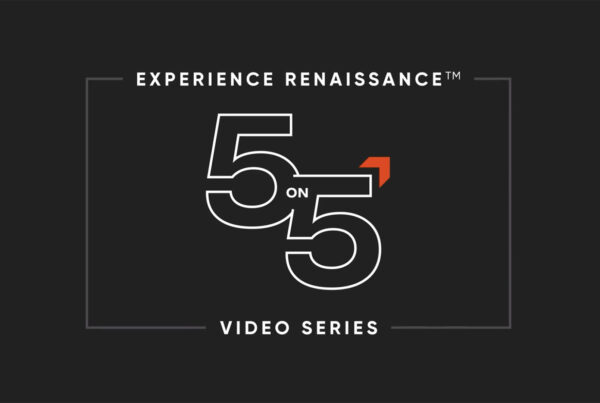THE EXPERIENCE RENAISSANCE™
Volume 4:
AI’s Role in Transforming Experience Design
Before there was AI…there was AI.
Allen Iverson.
An NBA Hall of Fame legend. A cultural icon. The face of Reebok.
Iverson’s global stardom landed him the ubiquitous global designation ‘AI.’
But beyond ‘AI’s accomplishments, fame, and prowess, he was…
HUMAN.
We now live in a world where Artificial Intelligence (AI) is trending anywhere and everywhere.
However, this time around, it’s not about crossovers, poster-dunks, and polarizing assists, but rather GPT meets DALL-E meets generative, generative, generative everywhere.
Said differently, this time around, AI is about technology.
As experiential leaders responsible for preparing, engaging, and inspiring audiences at the intersection of physical and virtual worlds, a new game of ‘one-on-one’ is emerging that poses a pivotal question: are we playing a game of Humans vs. AI or Humans + AI?
From stages to stories to screens, endless opportunities arise at a time in which the fundamental questions persist.
- What is the ‘best’ use of AI when creating a brand experience?
- Where does AI thrive within the evolving attendee journey?
- When are we engaging by way of humans, and when are we engaging by way of AI?
We think about AI differently: Actualizing Intention.
The importance of bringing greater intention to experience design is more critical now than ever before.
How 'Actualizing Intention' Elevates AI in Event Experiences
It’s not about AI for the sake of AI.
The initial approach to experience design remains the same – we aim to meet business desired outcomes by intentionally shaping how attendees feel, think, and act. With AI’s support, we can now refine this process and be even more intentional.
When you think of AI as “Actualizing Intention” – technology’s ability to execute tasks, make decisions, or produce results relative to our desired outcomes and those of our attendees – opportunities radiate and become more apparent. It’s more than just tech talk; it’s about transforming ideas into action in the most efficient way. We’re already using AI in everyday things – from phone voice assistants to personalized shopping suggestions online. So, if you’re considering diving deeper into AI, it’s not about chasing a trend. It’s about reaching endpoints that were previously impossible. As event planners and attendees alike seek ways to improve the event experience, it’s tempting to jump on the AI bandwagon immediately. However, actualizing intention can only be successful with the right strategy and human intervention.
Meet Your New Teammate
Good technology should bring about good human outcomes. Given as much, success in effectively harnessing AI requires collaboration. The path forward is not ‘AI vs. Human,’ but rather ‘AI + Human.’ And much like successfully working with a colleague, success with AI hinges, in part, on understanding its strengths as well as its blind spots.
The following represents a mere cross-section of ways in which AI brings greater intention to experience design.
Agendas That Think
We used to talk about the feeling of ‘personalized agendas.’ AI can now boost attendee satisfaction by actualizing that notion with agendas that think in real time providing session suggestions, content to consume, people to meet, areas to explore, and much more based on attendee personas. AI elevates our strategic approach to the attendee journey, increasing the success of individuals reaching their intended outcomes. Gone are the days of entering a networking event merely ‘hoping’ to encounter the ‘right’ contacts—AI has provided a solution to this challenge.
Extending Attendee Engagement
The shift from ‘event’ to ‘journey’ is enhanced and elevated with AI. We can better understand attendee behavior by their interactions with pre-event communications to guide a more prescriptive journey-like experience including the likes of recommended pre-event reads, recommended pre-event partners, etc. AI can also support with providing summaries of content, and offer ways to extend attendee engagement throughout their journey both during and post event.
Acting On Real-Time Feedback
AI can also collect real-time feedback to improve in-the-moment experiences – putting individuals at the center of the event by creating more two-way dialogue between the event and the attendee. It can also gather measurable data to increase event ROI, providing insight to achieve better experience outcomes.
Creating More Inclusive Environments
Some of the more practical use cases that can help save time and support a more inclusive experience include translations and captioning, helping to break down language barriers and connect individuals of all backgrounds. It can also help with routine tasks and enable planners to cater experiences to the specific needs of their audiences.
AI can leave an invaluable mark on the event production and planning experience, but it isn’t a one-size-fits-all approach.
Back To the Humans
Humans know what success looks like, including KPI specifics, leadership expectations, business considerations, and more. Most importantly, humans understand nuance and best know how to connect emotionally with other humans.
Humans also understand if a caption or translation is incorrect. Anything AI develops comes from learned data, therefore, the output needs to be examined and the model needs to be continuously trained. For the foreseeable future, this won’t be perfect. Also, AI-generated content is beginning to fill the internet, which could negatively impact future AI models. There needs to be a manual process and human intervention to ensure the right information comes out of an AI tool, and the model is learning new, accurate information to get ‘smarter.’
Humans are creative at heart and understand complex emotions and storytelling. And while AI can be an aid in planning and generating ideas, chatbots powered by AI invent information – known as “hallucinations” – at least 3% of the time and even as high as 27%! This is a serious issue for anyone sharing sensitive business information with AI chatbots, and it serves as a critical reminder that humans need to ensure anything AI generates is accurate.




